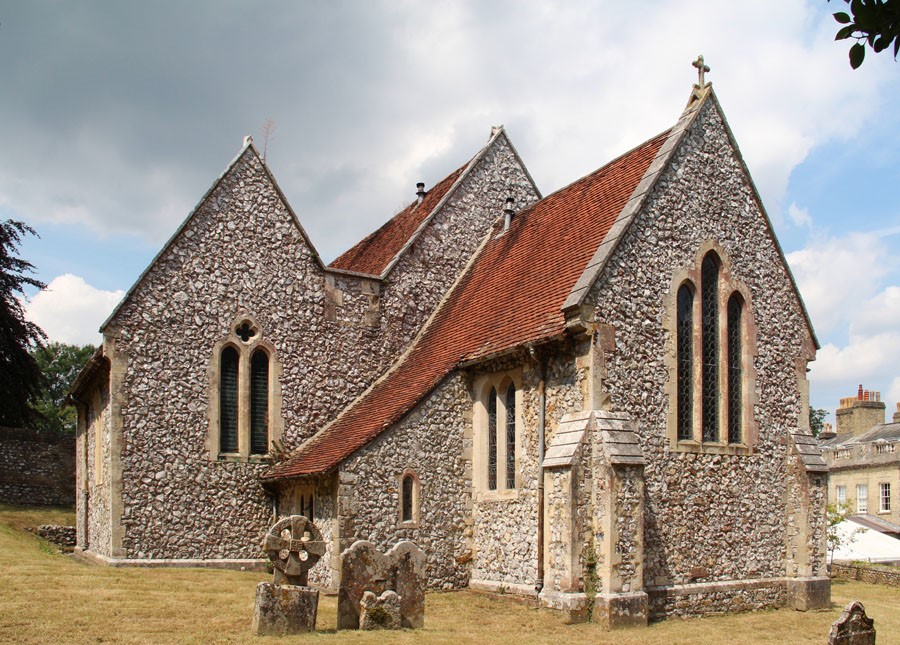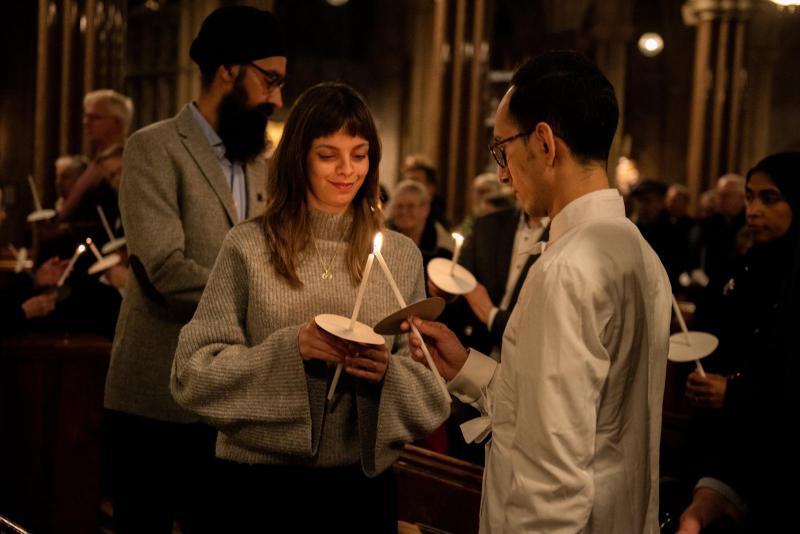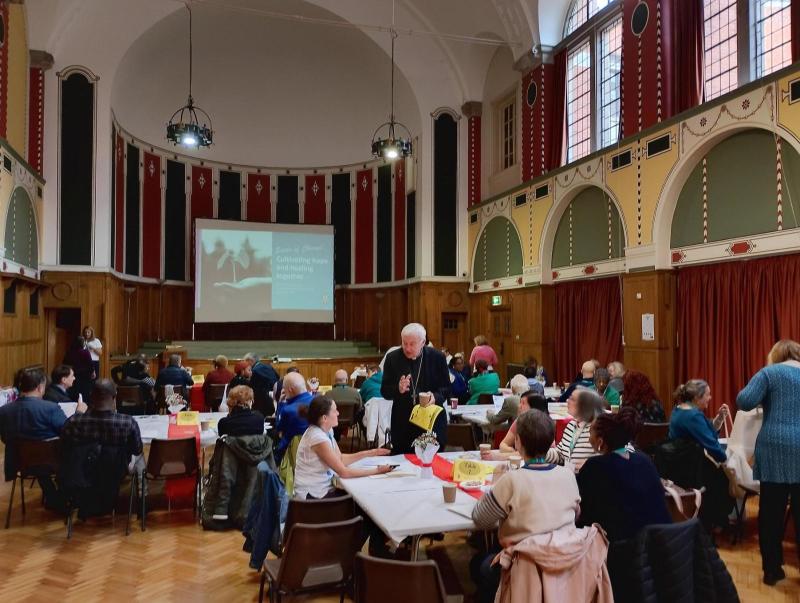by Fr Nicholas Schofield
Last time I wrote about Cardinal Manning’s wife, Caroline, and, as a result, was inspired to visit Lavington, the little village in West Sussex where they spent their married life and where he served as Rector for seventeen years. I especially wanted to see the church of St Peter and Caroline’s grave.
Lavington is in the heart of the South Downs, north of Chichester and not far from the great houses of Petworth and Goodwood. The biographies of Manning often talk in bucolic terms about this Downland parish but, unless you are a local, it takes a little time to find it. First, there is a problem of nomenclature. Now known as ‘East Lavington’, some still use the village’s traditional name of ‘Woolavington’ and, to add to the confusion, there is also a ‘West Lavington’ on the outskirts of nearby Midhurst. Then, once you arrive in ‘East Lavington’, you realise that the place is dominated by an independent school, Seaford College, and that Manning’s church serves as its chapel. It is not generally open to the public but the kindly receptionist accompanied us as we paid our respects.
Much has changed since Manning’s time but some elements remain constant, such as the close connection between the great house and the parish church in its grounds. The college uses the magnificent buildings that Manning would have known as Lavington Park; its occupants originally had the advowson of the parish, meaning they could choose the incumbent. Originally an Elizabethan mansion, the house was rebuilt at the end of the 18th century by the politician John Sargent, whose wife had inherited the property. He died in 1831 and was succeeded by his son, also called John, who was Rector of Lavington and Graffham. This dual role of being squire and parson is often referred to as ‘squarson’, not an unusual occurrence at the time. Unfortunately, this John died suddenly in 1833 and the young Manning, who had married one of his daughters, was presented to the living. Lavington Park became the home of Emily Sargent and her husband Samuel Wilberforce, son of the abolitionist and a future Anglican bishop.
Another constant is the beautiful countryside of the South Downs. The village stands in the shadow of the summits of Graffham Down and Woolavington Down and the forest of Charlton, all now traversed by the South Downs Way. The region has long been associated with sheep, kept by farmers not only for their own sake but also to fertilize the light Sussex soil and so ensure a good harvest of corn. The little church in Lavington was very much a shepherd’s church. Being a shepherd had its commitments and it was often impossible to leave the flock to attend church, especially during the lambing season. For this reason there was a charming Sussex custom, following the death of a shepherd, of nailing a tuft of wool on the coffin lid to explain to the recording angel why the deceased had so often missed his Sunday duties!
John Sargent had been a model shepherd of souls and Manning continued his example, first (briefly) as curate at Upwaltham and then as Rector in his own right of Lavington and Graffham. A member of his flock later recalled that ‘he counted to call on every house in his Parish once a fortnight – most of his visiting was done by walking – clad in cassock.’ Although he was strict and rather sober in his manner, he had a great affection for the local children and ‘looked like an Archangel when he prayed’. He took his pastoral responsibilities seriously, introducing daily morning and evening prayer. ‘It was a picturesque sight’, recalled one inhabitant of Lavington, ‘to watch the zealous and stately rector, vested in surplice, himself tolling the bell, whilst in the grey of a winter’s morning the straggling villagers hurried to morning prayer before going out to their daily toil in the fields.’
Despite the beauty of the Downs, this was no idyll. Though on one occasion Manning told his friend Gladstone, the future prime minister, that almost all his parishioners were communicant, there were still those who stayed away from church and showed little interest in the faith. Here, also, he first came face-to-face with widespread poverty and the aftermath of the Captain Swing riots. His concern for the underdog would mark the rest of his life.
The church of St Peter’s in Lavington is small and simple in its structure. Originally dating from the 13th century, much of what we see today is the work of Manning, who in 1846-47 added a transept, replaced the windows and built a new bell-tower. Most of the furniture, though, including the pulpit, altar, font and choir-stalls, is more recent. Outside in the graveyard, lined against the west wall, are the graves of Rev John Sargent, Bishop Samuel Wilberforce and his wife Emily, their son Herbert William Wilberforce of the Royal Navy (who died during the Crimean War) and Manning’s wife, Caroline. Some sources suggest that her grave was originally unmarked, partly because ‘he could not place the inscription he wished’, but she does indeed have a gravestone, now covered in lichen, and one can just make out the words: ‘Caroline, Wife of Henry Edward Manning, Born 1812, Died July 24th 1837.’
A short distance away, beyond the school grounds, is the old Rectory, now called ‘Beechwood House’, where Manning lived for 17 years. It was hard to see it properly from the little muddy road but, peering through the hedge, I could spot a majestic oak tree in the gardens and, gazing at the stately Georgian windows, wondered which room Manning had used as a study and where Caroline had died.
Lavington was not only the place where Manning served as a country parson. Here he worked also as Archdeacon of Chichester, making regular visits to the cathedral city and around the diocese, and achieving national prominence through his sermons and charges. It was here, also, that he moved away from his original evangelical outlook towards Rome, developing strong beliefs in the Real Presence, the dignity of the Priesthood and the action of the Holy Spirit within the Church. In later life, Manning would say ‘I became a Catholic off my own bat’. He was in touch with the discussions sparked off by the Oxford Movement, distributing the Tracts for the Times locally and co-writing one of them, Tract 78, on the subject of Catholic Tradition. But his conversion, like Newman’s, was largely the fruit of study, reflection and prayer.
He was keen to defend the Church from state interference and this issue would act as a catalyst for his conversion. It was the acceptance on the part of the Privy Council of the Rev GC Gorham and his unsound doctrines on baptismal regeneration that caused Manning finally to reconsider his position within the Anglican Communion. For several years he suffered great spiritual anguish, distancing himself from the actions of Newman and other converts and defending the Anglican via media on the one hand and privately doubting his own position on the other. By 1851, the year after the restoration of the hierarchy, the situation had become untenable and he decided to become a Catholic. This led to disapproval in many quarters and the painful parting of friends, but despite this it was good to see a portrait of Manning hanging on a back staircase of Seaford College!
‘I loved…the little church under a green hill-side,’ he later wrote as cardinal, ‘where the morning and evening prayers and the music of the English Bible for seventeen years became a part of my soul. Nothing is more beautiful in the natural order, and if there were no eternal world I could have made it my home.’
This article originally appeared in The Catholic Times on 16th March 2018. It is reprinted with kind permission of The Catholic Times.




